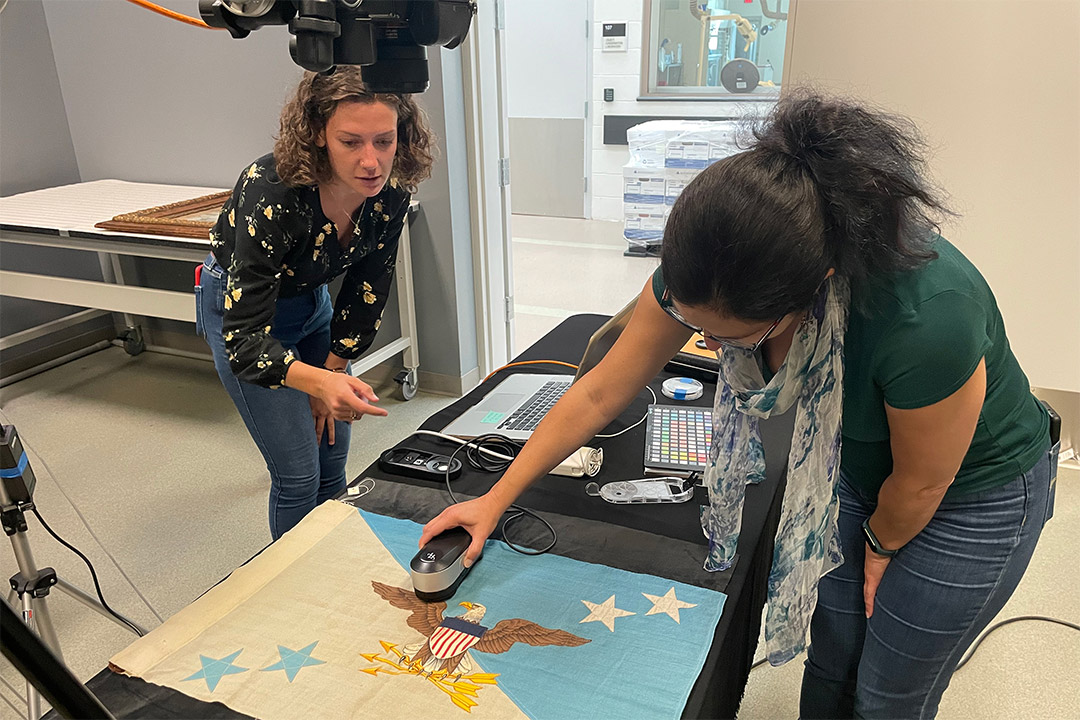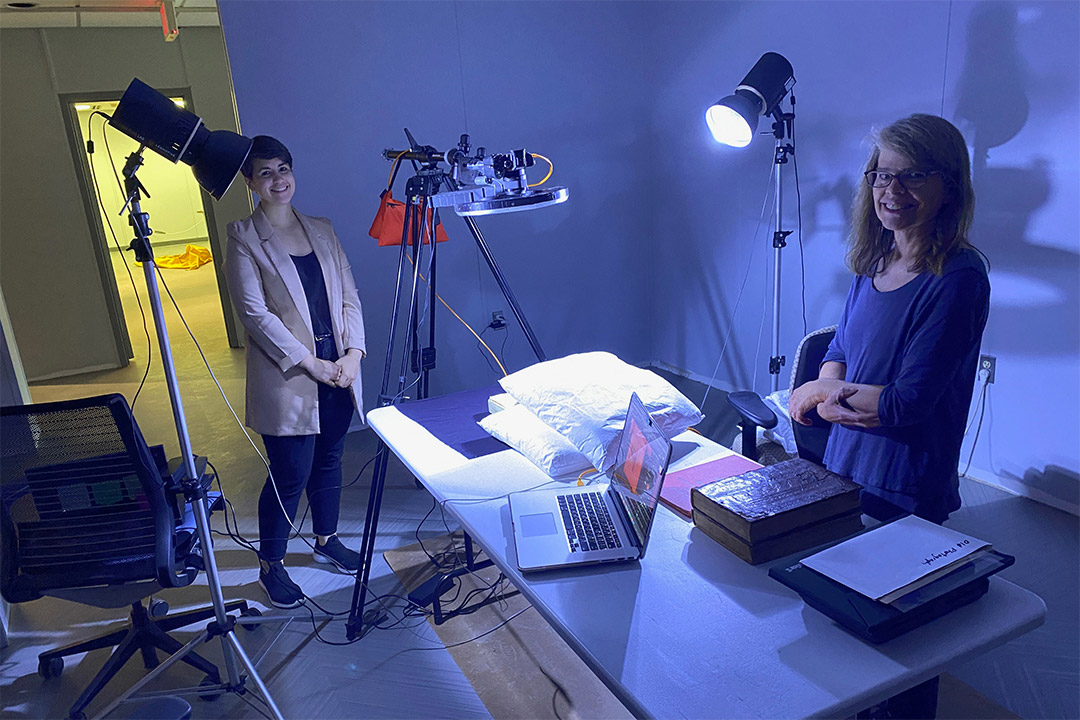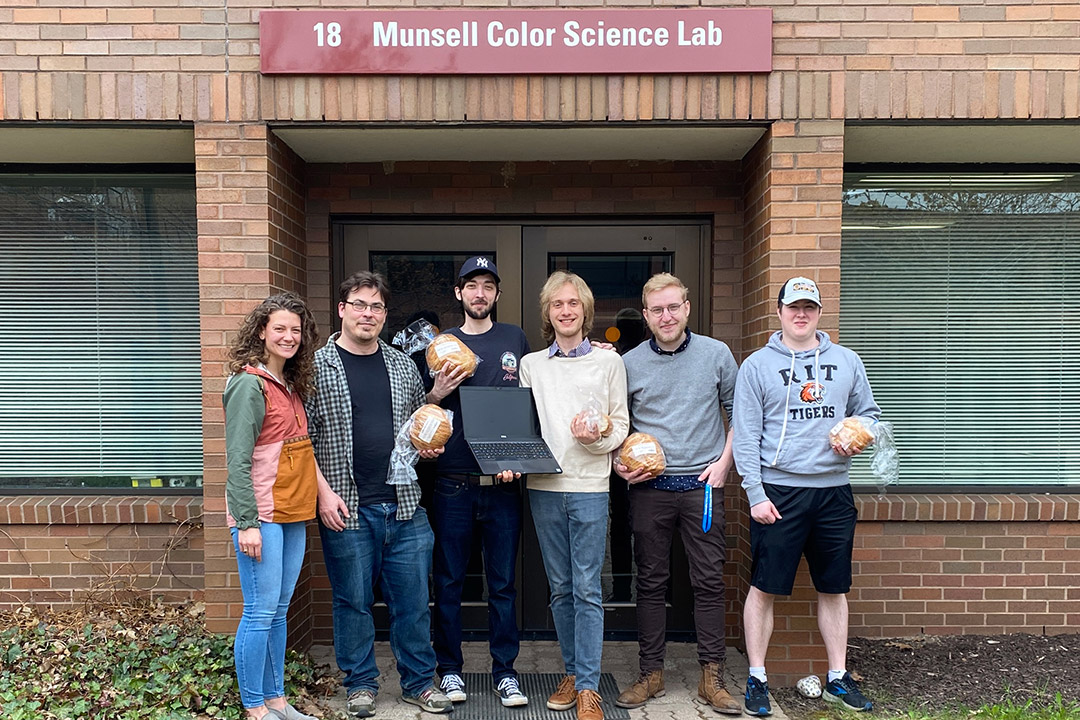RIT scientists develop spectral imaging techniques to help museums with conservation efforts
Munsell Color Science Laboratory researchers create LED-based methods using studio photography equipment
Leah Humenuck
Color science Ph.D. student Olivia Kuzio, left, tests LED-based spectral imaging techniques on artifacts at the U.S. Army Heritage and Education Center.
Scientists from Rochester Institute of Technology are turning studio photography technology on its head to help museums and other cultural heritage institutions preserve historically significant artifacts. Faculty and students from RIT’s Munsell Color Science Laboratory have developed new LED-based spectral imaging techniques they say will offer small to medium museums a practical way to capture accurate digital representations of items in their collections.
While spectral imaging is typically conducted in a laboratory setting with sophisticated and expensive equipment, Assistant Professor Susan Farnand and color science Ph.D. students Olivia Kuzio and Leah Humenuck have been developing methods to make spectral imaging more feasible for end users. They say the new methods will help museums in many ways, including digital and print reproduction, conservation treatment documentation, and exhibition lighting design.
Olivia Kuzio
Color science Ph.D. student Leah Humenuck and Assistant Professor Susan Farnand test LED-based spectral imaging techniques at the National Cryptologic Museum.
“When thinking about cultural heritage objects, you want to put out digital representations that look like the real thing so that people who are interested in learning more about the objects but might not be near the museum or object can look at an image and know it’s a good proxy for it,” said Kuzio. “It’s a way to honor the artists and the people who made these things.”
The researchers said most of the equipment needed for their new technique can either already be found in or can be easily obtained by a museum’s photography studio. They worked with five senior software engineering students last year to develop user-friendly software that performs the complex math behind the scenes and allows users to get the images and information they need in just a few clicks.
Stephanie Livingston-Heywood
Color science Ph.D. student Olivia Kuzio poses with five software engineering students who developed user-friendly software that performs the complex math behind the scenes and allows users to get the images and information they need in just two clicks. From left to right: Kuzio, Tristan Knox, Pat Dalesio, Jared Ponzetti, Jake O'Neil, and Andrew Hammerstone.
“We wanted this technology that was developed in the Munsell Color Science Laboratory to be available to medium and small museums and other cultural heritage institutions that don’t have big budgets,” said Farnand. “We think people should have access to it and we will continue to find ways to get it in the hands of people who are a bit more underserved.”
Throughout the spring and summer, the team of color scientists had end users test the software on artifacts. At RIT, they had museum studies students taught by Professor Juilee Decker test the software and also used it to image embroidered books from the Cary Graphic Arts Collection. The color scientists then took their new approach on the road, providing test runs to curators at the U.S. Army Heritage and Education Center, the National Cryptologic Museum, Buffalo State’s Art Conservation Department, and the Museum of Modern Art.
Farnand noted that the work builds on years of research by Professor Emeritus Roy Berns, funded through the Andrew W. Mellon Foundation. Now that they have collected user feedback, the team will work with a new group of senior software engineering students to develop a new version of the software—dubbed Beyond RGB 2.0. They hope to get the improved software in the hands of museum curators by the end of the spring semester.
This research is the latest of many recent advances in the field of cultural heritage imaging led by RIT. Researchers from the Chester F. Carlson Center for Imaging Science and museum studies program recently developed low-cost spectral imaging systems to help libraries and museums recapture lost and obscured text on historically significant documents. And in August, researchers from across the university showcased related projects at the first Cultural Heritage Imaging, Preservation, and Research (CHIPR) event.













